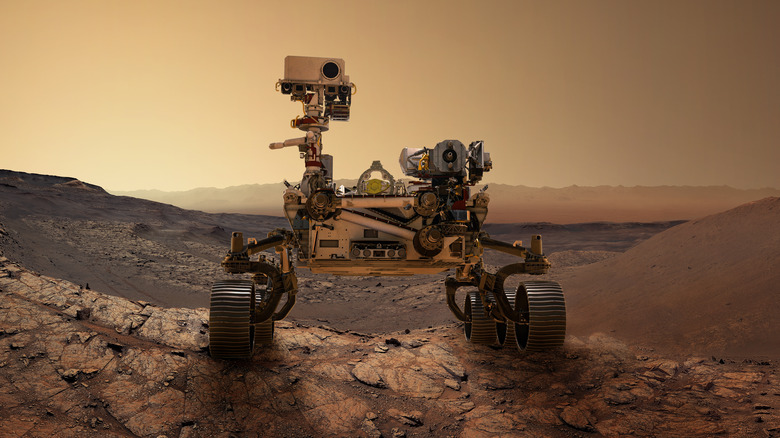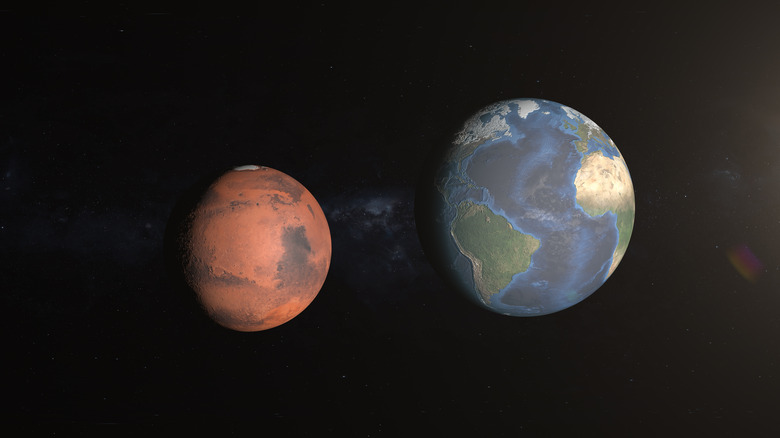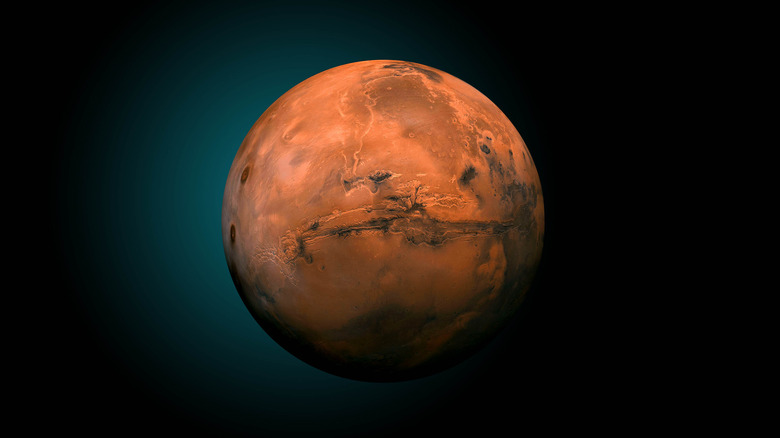Why Mars Has Two Speeds Of Sound
Sound speeds are able to tell researchers an impressive amount of information about a planet's surface, especially on Mars, which evidently has two separate speeds for low-pitched sound frequencies and high-pitched sound frequencies. The former travel at 537 mph, while the latter travel at 559 mph, according to NASA in a Perseverance Mars Rover update released on April 1. By comparison, Earth has just one speed at which all sound travels: a far snappier 767 mph. These measurements have been made by microphones utilized by the Mars rover Perseverence, which initially landed on the surface of the red planet on February 18, 2021. The mission has several directives, including the observation of changes in temperature and atmospheric pressure on the Martian surface, which can be determined by listening to Martian wind gusts and sandstorms.
Mars' atmosphere is vastly thinner than Earth's, and it is made primarily of carbon dioxide rather than oxygen and nitrogen, so it operates on its own set of rules that differ from those of our planet. Studying those rules in real-time is the primary objective of NASA's Perseverence rover, which is equipped with two microphones; one to record landing and general atmospheric noises, and a SuperCam science instrument that listens to the lasers that the Perseverence uses to zap rocks – doing so can help scientists determine mass and hardness of rocks on Mars, Planetary noted.
The properties of sound
Encyclopedia Britannica defines sound as a "mechanical disturbance from a state of equilibrium that propagates through an elastic material medium." Basically, what we think of as sound is caused by waves of acoustic energy that pass through particles in the air, (and solid matter, and liquid matter), creating vibrations of various shapes, sizes, and lengths, that can be interpreted by a listener based on how often the wave is able to reflect between particles.
The range and amplification of any given sound are heavily determined by the environment through which the acoustic waves pass. Air pressure, temperature, and density all play a role, which means that a high-pitched musical note played on a keyboard can sound quieter and travel a much shorter distance when played at an outdoor stadium versus in an indoor classroom, where it can be amplified by the walls, desks, and ceilings.
Science News noted that the split in frequencies takes place at 240 hertz, which is right around the middle C note in music. Anything above 240 hertz is considered a high-pitched noise, whereas anything below 240 hertz is low-pitched.
Why high-pitched sounds are nearly inaudible on Mars
Hotter temperatures generally decrease the density of a planet's atmosphere by spreading molecules farther apart, which means it's more difficult for acoustic waves to project very far. However, a cold and thin carbon dioxide-rich atmosphere can make high-pitched sounds evaporate very quickly. The same logic applies inversely — insofar that researchers may use the travel range and speed of sound to infer details about the composition and pressure of the atmosphere itself, which is what the NASA Perseverence rover is equipped to do.
That said, high-pitched sounds are almost inaudible on Mars beyond 26 feet, which is as far as the thin CO2-based atmosphere can carry them. However, Mars does have its own seasons as well, and NASA researchers are hoping that a Martian autumn can increase atmospheric pressure and create a noisier environment than the one that currently exists on the Red Planet. For those curious, NASA offers a collection of sounds as we would experience them while standing on Mars' surface.


